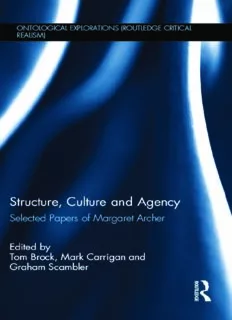
Structure, Culture and Agency: Selected Papers of Margaret Archer PDF
Preview Structure, Culture and Agency: Selected Papers of Margaret Archer
Structure, Culture and Agency ProfessorMargaretArcherisaleadingcriticalrealistandmajorcontemporarysocial theorist.Thiseditedcollectionseekstocelebratethescopeandaccomplishmentsof her work, distilling her theoretical and empirical contributions into four sections whichcapturetheessenceandtrajectoryofherresearchoveralmostfourdecades. Long fascinated with the problem of structure and agency, Archer’s work has constitutedadecade-longengagementwiththisperennialissueofsocialthought. However, in spite of the deep interconnections that unify her body of work, it is rarelytreatedasacoherentwhole.Thisisdoubtlessinpartduetotheunforgiving rigourofherargumentsandprose,butisalsoabyproductofsociology’songoing compartmentalisation. Thiseditedcollectionseekstoaddressthisrelativeneglectbycollatingaselection of papers, spanning Archer’s career, which collectively elucidate both the development of her thought and the value that can be found in it as a systematic whole.Thisbookillustratestheempiricaloriginsofhersocialontologyinherearly workonthesociologyofeducation,aswellasforegroundingthediverserangeof influences that have conditioned her intellectual trajectory: the systems theory of WalterBuckley,theneo-WeberiananalysisofLockwood,thecritical realist phil- osophyofRoyBhaskarand,morerecently,herengagementwithAmericanprag- matismandtheItalianschoolofrelationalsociology.Whatemergesisaseriesof importantcontributionstoourunderstandingoftherelationshipbetweenstructure, culture and agency. Acting to introduce and guide readers through these contri- butions, this book carries the potential to inform exciting and innovative socio- logicalresearch. TomBrockisLecturerinthedepartmentofSociologyatManchesterMetropolitan University,UK. Mark Carrigan is Research Fellow in the Centre for Social Ontology at the UniversityofWarwick,UK. GrahamScamblerisEmeritusProfessorofSociologyatUCL,UK,andVisiting ProfessorofSociologyatSurreyUniversity,UK. Ontological Explorations Othertitlesinthisseries ThePoliticsofChildhoodsRealandImagined Volume2:practicalapplicationofcriticalrealismandchildhoodstudies PriscillaAlderson CriticalRealism,EnvironmentalLearningandSocial-EcologicalChange EditedbyLeighPriceandHeilaLotz-Sisitka MetatheoryfortheTwenty-FirstCentury Criticalrealismandintegraltheoryindialogue EditedbyRoyBhaskar,SeanEsbjörn-Hargens, NicholasHedlundandMervynHartwig ThePost-MobileSociety Fromthesmart/mobiletosecondoffline EditedbyHidenoriTomita EnlightenedCommonSense Thephilosophyofcriticalrealism RoyBhaskar AComplexIntegralRealistPerspective Towardsanewaxialvision PaulMarshall CrisisSystem Acriticalrealistandenvironmentalcritiqueofeconomicsandtheeconomy EditedbyPetterNæssandLeighPrice Structure,CultureandAgency SelectedPapersofMargaretArcher EditedbyTomBrock,MarkCarriganandGrahamScambler Structure, Culture and Agency Selected Papers of Margaret Archer Edited by Tom Brock, Mark Carrigan and Graham Scambler Firstpublished2017 byRoutledge 2ParkSquare,MiltonPark,Abingdon,OxonOX144RN andbyRoutledge 711ThirdAvenue,NewYork,NY10017 RoutledgeisanimprintoftheTaylor&FrancisGroup,aninformabusiness ©2017selectionandeditorialmatter,TomBrock,MarkCarriganand GrahamScambler;individualchapters,thecontributors. TherightofTomBrock,MarkCarriganandGrahamScamblertobe identifiedastheauthorsoftheeditorialmaterial,andoftheauthorsfor theirindividualchapters,hasbeenassertedinaccordancewithsections77 and78oftheCopyright,DesignsandPatentsAct1988. Allrightsreserved.Nopartofthisbookmaybereprintedorreproduced orutilisedinanyformorbyanyelectronic,mechanical,orothermeans, nowknownorhereafterinvented,includingphotocopyingandrecording, orinanyinformationstorageorretrievalsystem,withoutpermissionin writingfromthepublishers. Trademarknotice:Productorcorporatenamesmaybetrademarksor registeredtrademarks,andareusedonlyforidentificationandexplanation withoutintenttoinfringe. BritishLibraryCataloguinginPublicationData AcataloguerecordforthisbookisavailablefromtheBritishLibrary LibraryofCongressCataloginginPublicationData Acatalogrecordforthisbookhasbeenrequested ISBN:978-1-138-93294-4(hbk) ISBN:978-1-315-67887-0(ebk) TypesetinTimesNewRoman bySunriseSettingLtd.,Brixham,UK Contents Foreword vii Acknowledgements x Introduction xiii Morphogenesis: realism’s explanatory framework 1 1 Thinking and theorizing about educational systems 36 2 On predicting the behaviour of the educational system 50 3 The myth of cultural integration 59 4 The vexatious fact of society 77 5 Morphogenesis versus structuration: on combining structure and action 102 6 For structure: its reality, properties and powers: a reply to Anthony King 128 7 The private life of the social agent: what difference does it make? 138 8 The ontological status of subjectivity: the missing link between structure and agency 151 9 Reflexivity as the unacknowledged condition of social life 165 10 A brief history of how reflexivity becomes imperative 184 vi Contents 11 Morphogenic society: self-government and self-organization as misleading metaphors 215 12 The generative mechanism reconfiguring Late Modernity 235 13 How agency is transformed in the course of social transformation: don’t forget the double morphogenesis 259 The trajectory of the morphogenetic approach: an account in the first person 282 Interview with Maggie 293 Structure, Culture and Agency: selected papers of Margaret Archer: annotated bibliography 306 Index 314 Foreword ItismyhonorandgreatpleasuretohavebeeninvitedtowritethisForewordtothe collected work of Margaret (or Maggie, as she prefers) Archer. In one sense, of course, the collection is a deserved tribute that expresses how the collectors feel abouther.Thecollection,however,isprimarilymeantasaservicetothefield.The factisthat,althoughcriticalrealistsspanmultipledisciplines–philosophy,theo- logy, education, business organization and more – among sociologists, Maggie Archerstandsfirst.Herwork,mostwell-knownandmostdrawn-upon,represents whatIhaveelsewherecalledthecanonicalpositionsofcriticalrealisminsociology. Itthusisaservicetoscholarsconcernedwithcriticalrealismthatencapsulatedhere inthiscollectionareArcher’smostseminalstatements. InthisbriefForeword,IwanttoidentifywhatIconsiderthecruxofArcher’s work.ButfirstIwouldliketotaketheopportunitytosaysomethingaboutherasa person. In his Sacred Project of American Sociology, Christian Smith describes meetingsoftheAmericanSociologyAssociation(ASA)as“tediouslystratified,” where“the‘best’sociologistslargelycirculateandtalkwiththeirownkind ::: In fact,mostofeveryone’seyemovementsattheASAmeetingsinvolvechecking out other people’s name tags, hung unceremoniously from lanyards around theirnecks,toseeiftheirnamesarerecognizableandatwhatcollegeoruniversity theywork.”1 AllIcansayisthat,bothasapersonandasasociologist,MaggieArcherdisplays no such status-orientation. As the biblical passage puts it, she is no “respecter of persons,”meaningthatsheisnotonetodifferentiatebysocialclass.Instead,Archer always,inmyexperience,distinguishesratherbycogencyofthought,findingit,if anything,moreamongtheobscurethanamongtheprominent.Incomparison,then, withwhatcharacterizesASAmeetings,Archer’spersonalandprofessionalopen- nessisveryrefreshing. Butletmeturntothework.Clearly,Archer’sworkspansdecadesanddevelops overtime.Thepresentcollectionmarksthatdevelopment.Clearly,Icannotcom- mentonitall.WhatIcandoisidentifywhatIbelieveiskeytoitall,namelytwo relatedpositions:AnalyticalDualismandtheMorphogenetic/Morphostatic(MM) approach.Asthelatterdependsontheformer,Iwillbeginwiththat. Contemporarysociologyislargelyuncomfortablewithbinarydistinctions.Itis uncomfortable with the realist distinction between subject and object; it is viii Foreword uncomfortable with the distinction between culture and agency; equally uncom- fortablewiththedistinctionbetweenstructureandagency;anduncomfortableeven withthedistinctionbetweencultureandstructure. Thatdiscomforthasledtoallkindsofcollapseor,inArcher’sword,conflation. For pragmatist and Bourdieusean perspectives, both widespread, the distinction betweensubjectandobjectandothersuchputativelyCartesianoppositionsaretobe overcomeeitherbysomesortofnon-realistdialecticorbytheconceptofhabitus. Withtheso-calledculturalturn,socialororganizationalstructurewasswallowedby culture(i.e.,reducedtorulesorschema),and,then,withtheso-calledpracticeturn, culture(andwithitnowstructure)hasbeenconflatedwithpractice(agency).The end is Hegel’s “night in which all cows are black.” Lost, that is, are the distinct conceptsthroughwhichtounraveldifferentkindsofsocialcausality. Against this conflationist tendency stands Archer’s analytical dualism. The designationmaynowbesomewhatmisleadingasthereareseveraldualismsArcher seeks to preserve. In Culture and Agency Archer sought to defend an analytical distinction between culture and agency. In Realist Social Theory she similarly arguedforananalyticaldistinctionbetweenstructureandagency.And, certainly, Archer affirms a distinction between culture and social structure. Thus, after Archer’s (2013) “Social Morphogenesis and the Prospects of Morphogenetic Society,”themoreencompassingstatementofpositionmaybewhatArchercalls SAC, the defense of structure, agency, and culture as three distinct ontological featuresofsocialreality,which,howeverintertwinedempirically,needtobesorted outanalyticallyinsocialexplanation. How the three get sorted out leads to the MM approach. The words morpho- genesisandmorphostasislookmoreimposingthantheyactuallyare.Theyreferto changeorconstancyofsocialform,andthatchangeorconstancyinvolvedialectical (i.e.,interactive)relationshipsovertimebetweensocialform(structureandculture) andagency.IpersonallyrelatethepointtoMarx’sdictum thatpeoplemaketheir own history but not under circumstances of their own making. The analytical dualism here distinguishes both the original and resulting circumstances or con- ditionsfromtheagentialmakingordoingpeopleperforminbetween. The circumstances in which people find themselves – and which they either reproduce or change – are both cultural and structural. Thus, there are distinct cultural and structural MM cycles that themselves intertwine, complicating the empirical analysis of actual processes. But unless the analytical distinctions associated with SAC are maintained, explanation will lapse, as it often does in sociology, into subjectivism, interactionism, or positivistic sociological holism. Together, SAC and the MM approach are the more abstract, meta-theoretical principlesthatwardagainstsuchadverseanalyticaltendencies. I call Archer’s SAC, the MM approach, and the associated conceptions of structure and culture the canonical positions among critical realist sociologists mainlytoregistertheirlackofuniversalembraceamongus.Therearecriticalrealist sociologistswhodisagreewithsomeelements.ButitwasArcherwhoconvinced Roy Bhaskar that his original Transformational Model of Social Action (TMSA) was too beholden to the conflations of Giddens’s structuration theory; and it is Foreword ix Archer whose views remain dominant among critical realist sociologists. And, together,SACandtheMMapproacharekeytoArcher’sviews. DougPorpora Note 1 ChristianSmith,TheSacredProjectofAmericanSociology(Oxford,NewYork:Oxford UniversityPress,2014),pp.136–7. Reference 1 Archer, M.S. (2013) “Social Morphogenesis and the Prospects of Morphogenetic Society,”inArcher,M.S.(ed.),SocialMorphogenesis.NewYork:Springer,pp.1–22.
Description: